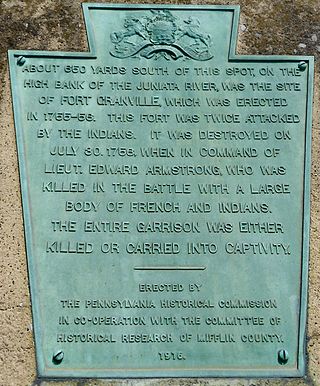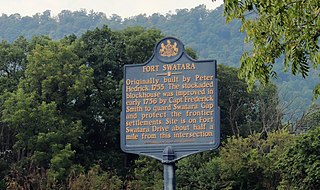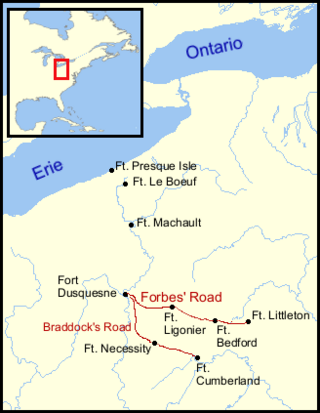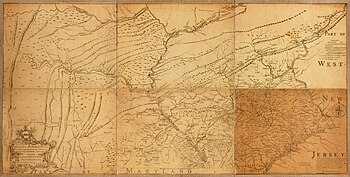
Fort Prince George was an uncompleted fort on what is now the site of Pittsburgh, at the confluence of the Allegheny and Monongahela Rivers in Allegheny County, Pennsylvania. The plan to occupy the strategic forks was formed by Virginia Lieutenant Governor Robert Dinwiddie, on the advice of Major George Washington, whom Dinwiddie had sent on a mission to warn French commanders they were on English territory in late 1753, and who had made a military assessment and a map of the site. The fort was still under construction when it was discovered by the French, who sent troops to capture it. The French then constructed Fort Duquesne on the site.

Shamokin was a multi-ethnic Native American trading village on the Susquehanna River, located partially within the limits of the modern cities of Sunbury and Shamokin Dam, Pennsylvania. It should not be confused with present-day Shamokin, Pennsylvania, located to the east. The village was the focus of missionary efforts, and then was the staging area for raids on English settlements in Pennsylvania during the French and Indian War. It was burned and abandoned by the Lenape in May, 1756. A few months later, Fort Augusta was constructed on the site of the village.
Fort Bedford was a French and Indian War-era British military fortification located at the present site of Bedford, Pennsylvania. The fort was a star-shaped log fortress erected in the summer of 1758.

Fort Loudoun was a fort in colonial Pennsylvania, one of several forts in colonial America named after John Campbell, 4th Earl of Loudoun. The fort was built in 1756 during the French and Indian War by the Second Battalion of the Pennsylvania Regiment under Colonel John Armstrong, and served as a post on the Forbes Road during the Forbes expedition that successfully drove the French away from Fort Duquesne. The fort remained occupied through Pontiac's War and served as a base for Colonel Henry Bouquet's 1764 campaign. In the 1765 Black Boys Rebellion, Fort Loudoun was assaulted by angry settlers, when their guns were confiscated after they destroyed supplies intended for Native Americans. The garrison retreated to Fort Bedford and the fort was abandoned.

Fort Machault was a fort built by the French in 1754 near the confluence of French Creek with the Allegheny River, in northwest Pennsylvania. The fort helped the French control these waterways, part of what was known as the Venango Path from Lake Erie to the Ohio River. It was one of four forts designed to protect French access to the Ohio Country and connections between its northern and southern colonies. From north to south the forts were Fort Presque Isle, Fort Le Boeuf, Fort Machault, and Fort Duquesne, at the Forks of the Ohio. The fort was abandoned by the French in 1759, and burned so that the British could not use it. It was replaced by the British in 1760 with Fort Venango.
Fort Augusta was a stronghold in Northumberland County, Pennsylvania, in the upper Susquehanna Valley from the time of the French and Indian War to the close of the American Revolution. At the time, it was the largest British fort in Pennsylvania, with earthen walls more than two hundred feet long topped by wooden fortifications. With a garrison of over 300 troops and walls specially constructed to resist artillery, it presented a formidable defense and was never attacked. It served as a refuge for local settlers during the French and Indian War and during the American Revolutionary War. It was abandoned in 1780 and dismantled in 1796.
Manada Gap is an unincorporated community in East Hanover Township, Dauphin County, Pennsylvania, United States, located in the Harrisburg-Carlisle area, near Fort Indiantown Gap.

Fort Granville was a militia stockade located in the colonial Province of Pennsylvania. Its site was about a mile from Lewistown, in what is now Granville Township, Mifflin County. Active from 1755 until 1756, the stockade briefly sheltered pioneer settlers in the Juniata River valley during the French and Indian War. The fort was attacked on August 2, 1756, by a mixed force of French troops and Native Americans, mostly Lenape warriors. The fort’s garrison surrendered the strongpoint to these attackers, who celebrated their victory and destroyed the stockade.

Fort Shirley was a military fort located in present-day Shirleysburg, Pennsylvania. It was built in 1755 by George Croghan and later maintained by the Province of Pennsylvania during the French and Indian War. Fort Shirley was part of a defensive line of forts built in Pennsylvania during 1755 and 1756, at the start of hostilities with the French and their allied Native Americans. Although two French and Native American war parties were sent to capture it, Fort Shirley was never attacked. The fort served as the launching site for the Kittanning Expedition in September 1756, after which it was abandoned.

Fort Dobbs was an 18th-century fort in the Yadkin–Pee Dee River Basin region of the Province of North Carolina, near what is now Statesville in Iredell County. Used for frontier defense during and after the French and Indian War, the fort was built to protect the American settlers of the western frontier of North Carolina, and served as a vital outpost for soldiers. Fort Dobbs' primary structure was a blockhouse with log walls, surrounded by a shallow ditch, and by 1759, a palisade. It was intended to provide protection from French-allied Native Americans such as the Shawnee raids into western North Carolina.
William Clapham was an American military officer who participated in the construction of several forts in Pennsylvania during the French and Indian War. He was considered a competent commander in engagements with French troops and Native American warriors, but towards the end of his military career he was unpopular with troops under his command. Following his retirement from the army, he and his family were killed by Lenape warriors on his farm in 1763.

The Bloody Springs massacre was an attack by Lenape warriors on homesteads in what is now Berks County, Pennsylvania, on October 1, 1757, during the French and Indian War. The Spatz family and other settlers were killed at a spring near modern-day Strausstown, Pennsylvania, causing the water to run red with the blood of the family. The story of the massacre has been passed down through the Degler family, whose farm was adjacent to the Spatz homestead.

Fort Swatara was a stockaded blockhouse built during the French and Indian War in what is now Lebanon County, Pennsylvania. Initially a farmstead surrounded by a stockade, provincial troops occupied it in January 1756. The fort safeguarded local farms, but a number of settlers were killed by small Native American war parties. The fort was abandoned in May 1758.

Fort Lyttleton, also known as Fort Littleton, was a militia stockade located in the colonial Province of Pennsylvania. Its site was about a mile from Fort Littleton, Pennsylvania, near Dublin Township, in what is now Fulton County, Pennsylvania. Active from 1755 until 1763, the stockade was initially garrisoned by 75 Pennsylvania troops but at times had as many as 225. It was in use until 1759, then abandoned and reoccupied briefly in 1763 during Pontiac's War.
Fort Allen was a military structure built in Franklin Township, in Carbon County, Pennsylvania in 1756. It was first of several frontier defenses erected by Benjamin Franklin for the Province of Pennsylvania during the French and Indian War. The garrison was rarely more than fifty men, and the fort never saw combat, however it became a center of contact and trade with Native Americans and served as a stopping point for Indians traveling to and from Bethlehem, Easton and Philadelphia. It was abandoned in 1761 near the end of the French and Indian War, and briefly reoccupied during Pontiac's War and again during the American Revolutionary War.

The Great Cove massacre was an attack by Shawnee and Lenape warriors led by Shingas, on the community of Great Cove, Pennsylvania on 1 November 1755, in which about 50 settlers were killed or captured. Following the attack, settlers returned to the community to rebuild, and the Provincial Council of Pennsylvania began constructing a chain of forts and blockhouses to protect settlers and fend off further raids. These forts provided an important defense during the French and Indian War.

The Gnadenhütten massacre was an attack during the French and Indian War in which Native allies of the French killed 11 Moravian missionaries at Gnadenhütten, Pennsylvania on 24 November 1755. They destroyed the mission village and took one woman prisoner, and only four of the sixteen residents escaped. Following the attack, Benjamin Franklin was commissioned by the Pennsylvania Provincial Council to construct forts in the area, and in other parts of the Province of Pennsylvania, to defend against Native American attacks, which were becoming increasingly frequent due to the French and Indian War.
Fort Hunter was a military fort located in present-day Fort Hunter, Pennsylvania. It was initially a stockaded gristmill fortified by Samuel Hunter in 1755 and later enlarged and maintained by the Province of Pennsylvania during the French and Indian War. Fort Hunter was part of a defensive line of forts built in Pennsylvania during 1755 and 1756, at the start of hostilities with the French and their allied Native Americans. It was briefly used during Pontiac's War, then abandoned in 1763.

Fort Northkill was a fort in colonial Pennsylvania, built to protect settlers from attacks by French-allied Native Americans during the French and Indian War. Although the fort was garrisoned by Pennsylvania militia, they were unable to prevent continued attacks on local farmsteads, but the fort did provide some protection for the settlers themselves. The fort appears to have been abandoned in September 1757, but the exact date is unknown.
Fort Lebanon was a Pennsylvania stockade fort built in December 1755 and designed to provide protection for settlers' families during the French and Indian War. However, Native American war parties often attacked nearby farms and killed settlers, disappearing before the fort's troops could respond. The garrison was sometimes fewer than 25 men as troops were transferred for temporary duty elsewhere, meaning that the fort had little manpower for patrols or to pursue attackers. The fort was renamed Fort William in mid-1757. In May 1758, the garrison was transferred and the fort was never re-occupied.
















